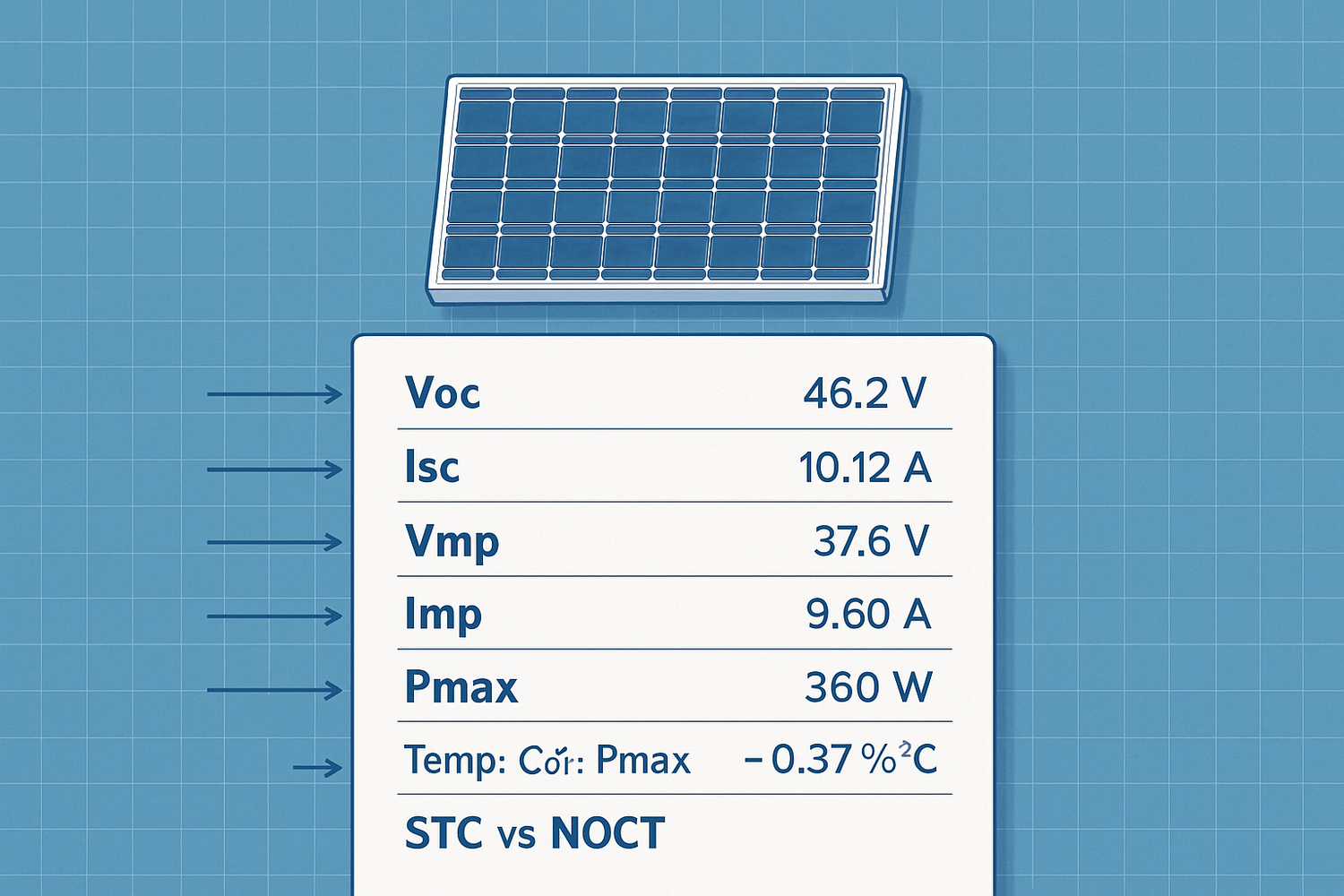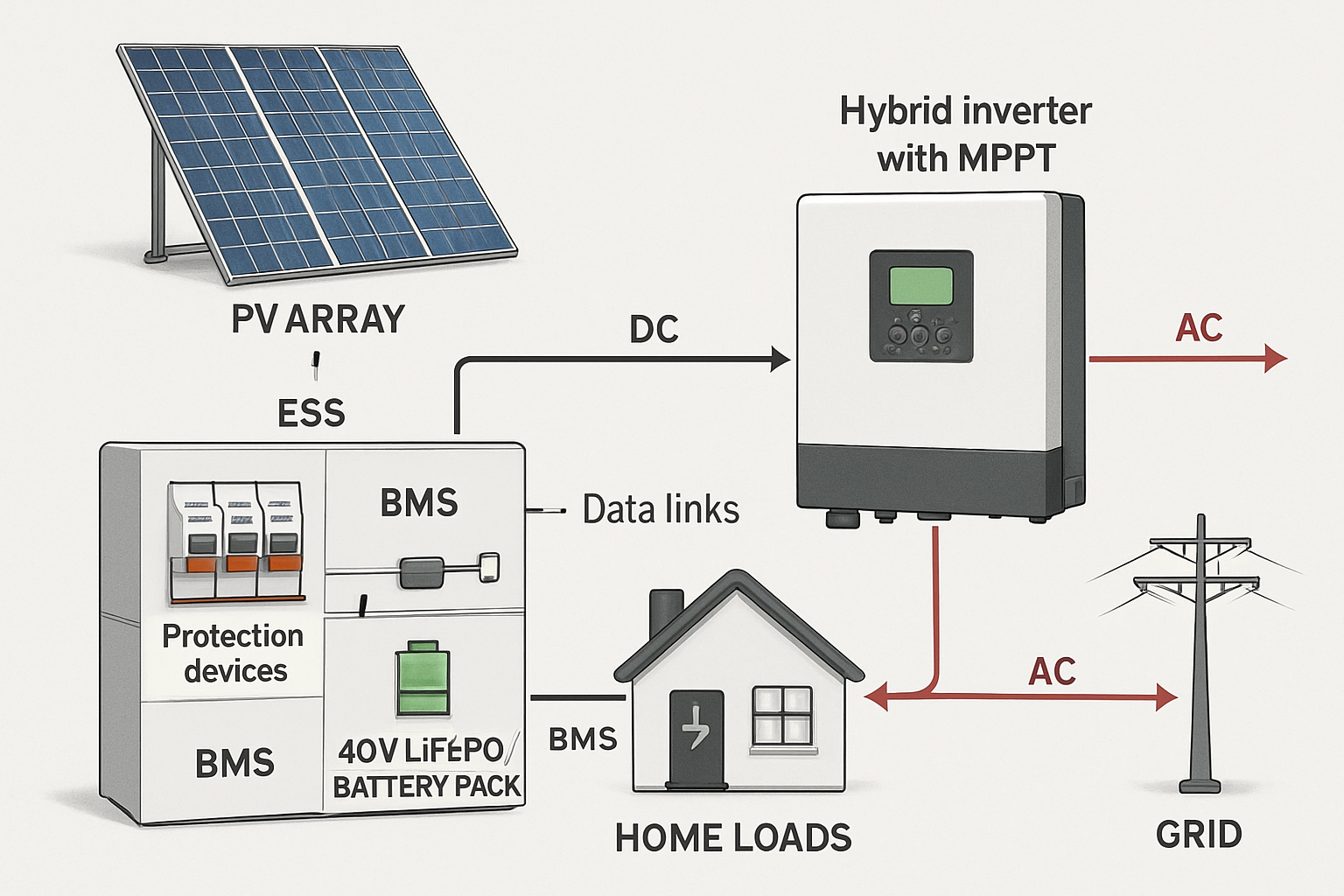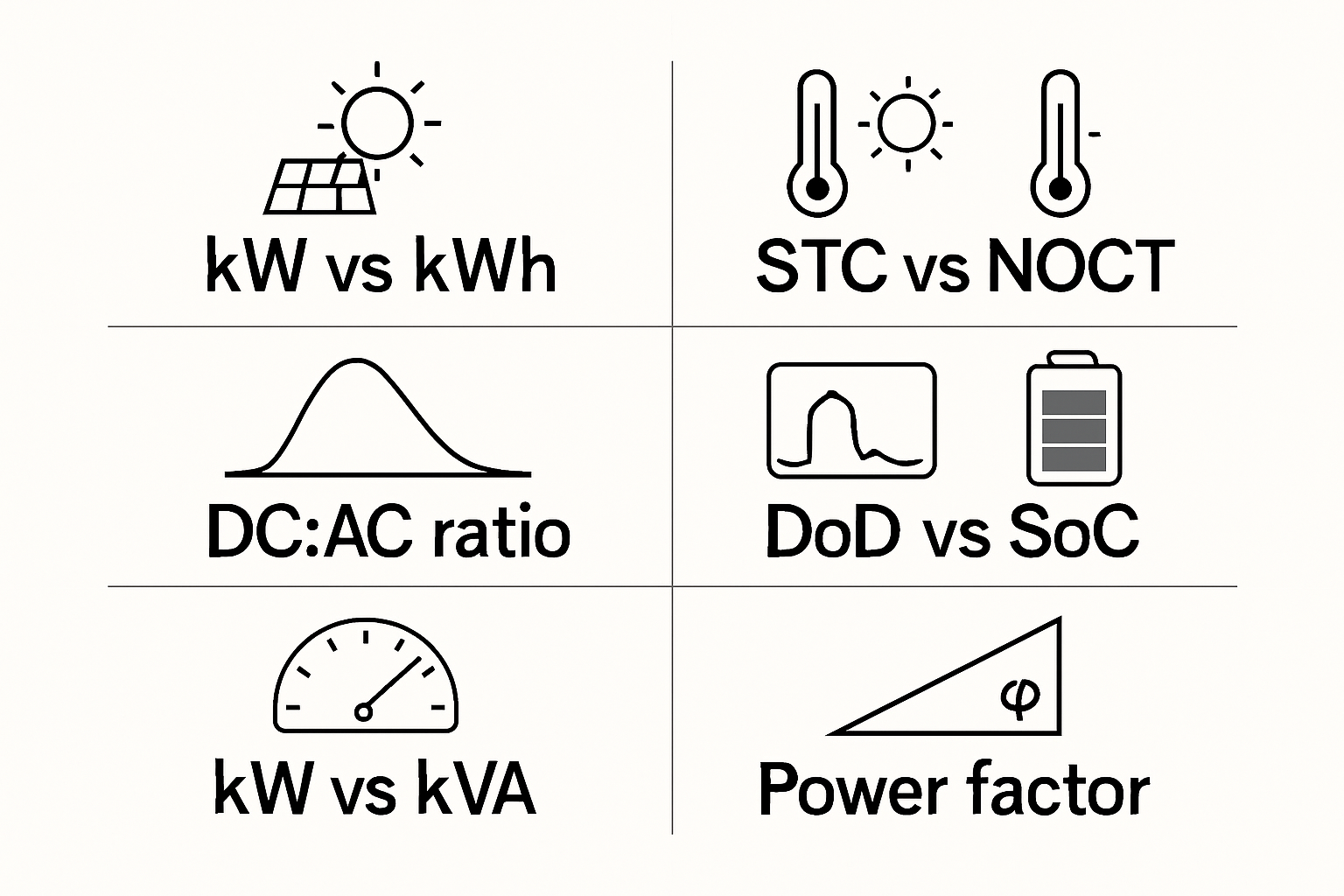Reading a PV spec sheet fast and accurately helps you size strings safely, match inverters, and get realistic energy expectations. This piece focuses on three lines you see on every module label: VOC, ISC, and STC. You will also see related fields like VMP, IMP, Pmax, temperature coefficients, and NOCT. Together they determine voltage windows, current limits, and yield.

Core terms at a glance
Keep these core items in mind while scanning any PV spec sheet.
| Field | What it is | Typical impact | Quick check |
|---|---|---|---|
| VOC (Open‑Circuit Voltage) | Module voltage with no load attached | Sets series string count limit at cold temps | Use cold correction to avoid exceeding inverter max DC |
| ISC (Short‑Circuit Current) | Current with terminals shorted | Sets parallel string and fuse sizing | Multiply by strings and code factor to check MPPT input limits |
| VMP / IMP | Voltage / current at maximum power | Determines operating voltage window and wire loss | VMP must sit inside inverter MPPT range |
| Pmax | Rated power at STC | Marketing nameplate; higher is not always better | Confirm against module tolerance and temperature derate |
| STC | Standard Test Conditions: 1000 W/m², 25°C cell, AM 1.5 | Defines nameplate values used on datasheets | Real output is usually lower than STC |
| NOCT / NMOT | 800 W/m², 20°C ambient, 1 m/s wind (typ. cell ~45°C) | Better proxy for field performance | Use temperature coefficients to estimate hot-day power |
| Temp. Coefficients | Percent change per °C for Voc, Isc, Pmax | Voltage falls with heat; Voc rises in cold | Apply to site min/max temps for safe design |
Why these numbers matter for design
Voltage and current margins protect equipment and uptime:
- Cold mornings increase VOC. Strings can exceed inverter max DC if you do not correct for temperature.
- Hot roofs reduce VMP and Pmax. Yield and MPPT tracking range must still align.
- Parallel strings increase ISC into the combiner and MPPT. Respect input current and short‑circuit limits.
Industry reports emphasize using variable renewable output first due to near‑zero fuel cost, which makes stable and predictable DC sizing even more valuable. As noted in Getting Wind and Solar onto the Grid, variable renewable electricity has very low marginal cost and shifts the net demand profile. Designing PV strings that avoid nuisance trips supports higher utilization of that low‑cost PV energy.
Step‑by‑step: read a PV spec sheet like a designer
1) Collect the right rows
- Pmax, VMP, IMP at STC
- VOC, ISC at STC
- Temperature coefficients: βVoc (%/°C), αIsc (%/°C), γPmp (%/°C)
- NOCT (or NMOT) and module tolerance
2) Correct VOC for your coldest site temperature
Use the VOC coefficient to calculate the worst‑case open‑circuit voltage. A negative βVoc means voltage rises as temperature drops.
Formula: Voc_cold = Voc_STC ×
Example module (typical 400 W class): Voc = 50.0 V, VMP = 41.0 V, ISC = 10.5 A, IMP = 9.8 A, βVoc = −0.28%/°C, αIsc = +0.05%/°C, γPmp = −0.36%/°C.
Site: Tmin = −15°C. Delta = 25 − (−15) = 40°C. Voc_cold ≈ 50.0 × = 55.6 V.
Max modules in series n_max = floor(Vdc_max_inverter ÷ Voc_cold):
| Inverter max DC (V) | Voc_cold per module (V) | n_max (floor) |
|---|---|---|
| 600 | 55.6 | 10 |
| 1000 | 55.6 | 17 |
Pick a count that also lands VMP_string inside the MPPT window at operating temperatures. For 17 modules, VMP_string at STC ≈ 17 × 41.0 = 697 V.
3) Check current on the MPPT and protection
Use ISC for protection sizing and inverter input limits. For N parallel strings:
Isc_total = N × Isc_module. Apply local code factor (commonly 1.25× for continuous current). Example: three strings → 3 × 10.5 = 31.5 A; with 1.25× factor ≈ 39.4 A. Verify this does not exceed the MPPT short‑circuit rating and any combiner fuse/terminal ratings. Regulations vary by country; consult local codes. Non‑legal advice.
4) Estimate hot‑day operating points
Cells run hot under sun. With NOCT around 45°C, the cell is 20°C above STC. Apply coefficients:
- Pmax_hot ≈ Pmax_STC × = 400 W × ≈ 371 W
- VMP_hot ≈ VMP_STC × . If −0.30%/°C, then ≈ 41.0 × (1 − 0.0030 × 20) ≈ 38.6 V
- ISC_hot ≈ ISC_STC × ≈ 10.5 × (1 + 0.0005 × 20) ≈ 10.6 A
| Condition | Irradiance (W/m²) | Cell temp (°C) | Pmax per module (W) | VMP (V) | IMP (A) |
|---|---|---|---|---|---|
| STC | 1000 | 25 | 400 | 41.0 | 9.8 |
| NOCT example | 800 | 45 | ≈371 | ≈38.6 | ≈9.9 |
These quick corrections set realistic expectations for yield and confirm the string stays inside the MPPT voltage window on hot days.
Real design tips that prevent call‑backs
- Leave headroom on VOC: Aim for 5–10% margin under the inverter’s max DC after cold correction, especially in alpine or continental climates.
- Match MPPT windows: Keep VMP_string under typical heat at least 1.1× above the lower MPPT limit for stable tracking in summer.
- Respect input current specs: Compare both maximum input current and maximum short‑circuit current per MPPT. If parallel strings push over the limit, add MPPTs, raise series count, or pick a module with lower ISC.
- Consider ILR (inverter loading ratio): A DC/AC ratio of ~1.1–1.4 is common. Higher ILR raises clipping risk during cool, clear hours. The IEA Next‑Generation Wind and Solar Power stresses value‑based design choices as variable renewables scale.
- String symmetry: Keep modules per string equal and use modules from the same bin to minimize mismatch.
How this connects to grid and storage performance
As noted in Getting Wind and Solar onto the Grid, net demand is the system load after variable renewables are subtracted. Clean DC sizing helps your inverter ride through rapid irradiance changes without overvoltage trips, so more zero‑fuel‑cost PV energy is used first. The IEA Solar PV Roadmap adds that steady scaling needs consistent practices across financing, planning, and standards—reading spec sheets correctly is part of that consistency. The U.S. Department of Energy Solar Energy Technologies Office publishes foundational PV concepts and acronyms that align with these spec‑sheet terms, supporting aligned terminology in projects and procurement. Broad market data from the EIA also illustrates how PV penetration keeps rising, which raises the payoff from precise DC/AC matching and robust protection settings.
If you pair PV with LiFePO4 storage in a hybrid inverter, confirm the PV array stays inside the hybrid’s MPPT window across temperatures, and that ISC limits per MPPT are respected. Correct string sizing protects the inverter’s DC stage and avoids nuisance restarts that can interrupt battery charging.
Worked string‑sizing snapshot
Goal: Design one MPPT with a 1000 VDC inverter in a cold climate (−15°C min), using the 400 W module above.
- Cold VOC: 55.6 V
- Max in series: floor(1000 / 55.6) = 17
- Check MPPT window: Suppose 250–850 V. On a hot day, VMP per module ≈ 38.6 V, so 17 × 38.6 ≈ 656 V → inside the window
- Parallel strings: 3 strings → ISC_total ≈ 39.4 A after 1.25× factor → confirm under MPPT short‑circuit and input current ratings
This string plan avoids over‑voltage in the cold and stays trackable in the heat, while remaining under current limits. That reduces trips and preserves energy harvest during clear, cool mornings that often set daily peaks.
Common pitfalls and quick fixes
- Using STC power to size DC wire and protection. Fix: Always check ISC with code factors and temperature.
- Ignoring module tolerance bins. Fix: For long series strings, a few low‑V bins can pull VMP down; keep bins consistent.
- Forgetting site extremes. Fix: Use actual Tmin/Tmax from local weather files, not generic values.
- Neglecting shading on current. Fix: Shade kills current first; bypass diodes reduce loss across a cell block but also lower VMP. Design for shade tolerance or use MLPE as needed.
What the reports say
- According to Getting Wind and Solar onto the Grid, variable renewable output has very low marginal cost and shifts net demand, pushing designers to prioritize reliable PV uptime and stable DC sizing.
- The IEA Solar PV Roadmap underscores the role of standards and consistent engineering practice across the PV value chain, which includes using common STC definitions on spec sheets.
- Next‑Generation Wind and Solar Power highlights the transition from pure cost focus to value‑based design—good DC/AC matching and temperature‑aware string sizing improve system value.
- The DOE Solar Energy Technologies Office provides terminology and program context that align with VOC, ISC, STC, and related PV acronyms used in design and procurement.
Safety and compliance
Work on PV DC circuits can be hazardous. Use insulated tools, PPE, and lockout/tagout. Open‑circuit strings carry high voltage; shorted strings carry high current. Follow local electrical codes and product manuals. Non‑legal advice.
FAQs
How do I pick series count if my site has rare −25°C events?
Use the true historical minimum ambient, not average winters. Recalculate VOC_cold with that Tmin and leave margin under the inverter’s max DC. If margin shrinks, reduce modules in series or choose a higher‑voltage inverter.
Does ISC change much with temperature?
Compared to voltage, current changes little. A typical αIsc is about +0.04% to +0.06%/°C. Even so, account for it in MPPT current checks and overcurrent protection.
Why is field power lower than STC?
STC uses 25°C cell temperature and 1000 W/m² irradiance. Roof‑mounted modules often run 20–35°C hotter than 25°C at noon, which cuts voltage and power. Use temperature coefficients and NOCT/NMOT to estimate field output.
Can higher Pmax always increase energy?
Not always. If higher‑power modules raise VOC or ISC beyond safe limits, you might lose uptime. Fit the module’s electrical profile to the inverter’s voltage/current windows first; then compare energy yield and cost.





Leave a comment
All comments are moderated before being published.
This site is protected by hCaptcha and the hCaptcha Privacy Policy and Terms of Service apply.